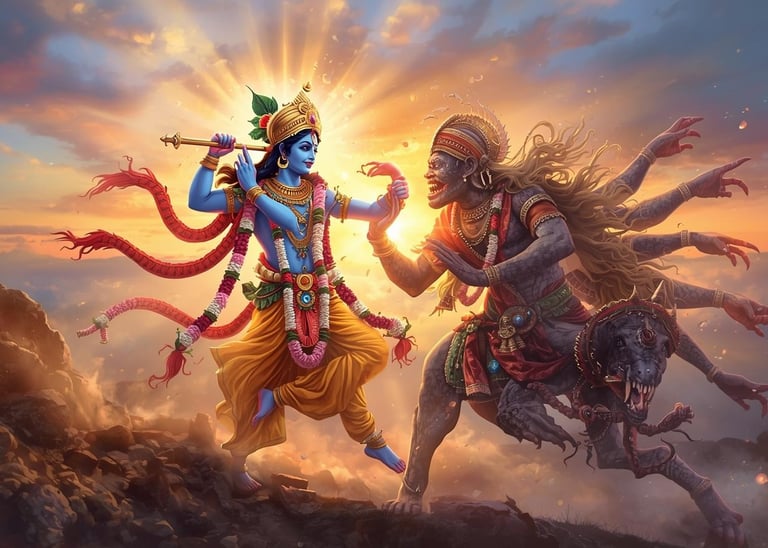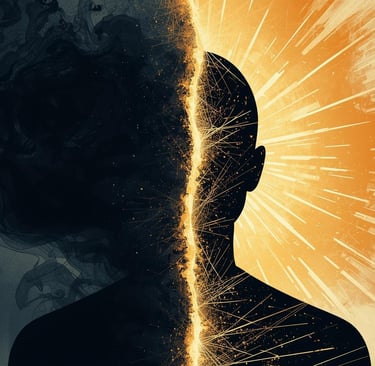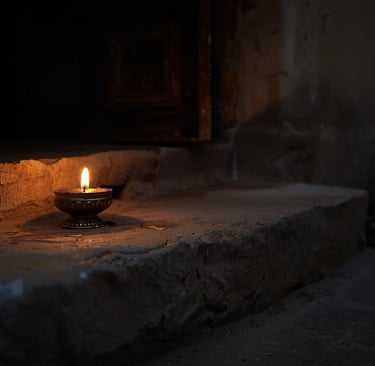Diwali Festival in India: Naraka Chaturdashi - Destroying Darkness Within
Diwali Festival is Positive Energy. Part 2
Gajanan L. Bhonde
10/18/202513 min read


Introduction to Diwali and Naraka Chaturdashi
Diwali, often referred to as the Festival of Lights, is one of the most significant cultural and religious celebrations in India. It is celebrated by millions across the country and around the world, symbolizing the victory of light over darkness and good over evil. This vibrant festival typically spans five days, each day holding its own unique significance and rituals. The culmination of these celebrations takes place on Amavasya, the new moon night, with families adorning their homes with lamps and lights to welcome the Goddess Lakshmi, who is believed to bring wealth and prosperity.
Among the festivities, Naraka Chaturdashi—also known as Choti Diwali—holds a special place. Observed two days before the grand Diwali, this day commemorates Lord Krishna’s legendary triumph over the demon Narakasura. According to Hindu mythology, Narakasura's reign of terror caused suffering and fear among his subjects. Lord Krishna’s victory represents the eradication of evil and the restoration of peace and harmony. The rituals performed on this day signify the embrace of light, joy, and a renewed spirit.
On Naraka Chaturdashi, devotees partake in the traditional practice of early morning baths, believed to purify both the body and mind, helping to chase away negativity. People also engage in the lighting of diyas, preparing sweets, and conducting prayers to express gratitude for the blessings received. The significance of this festival extends beyond the personal; it emphasizes the importance of unity and communal harmony, as families come together to celebrate. As the festival progresses into Diwali, the themes of love, family, and the victory of good continue to resonate, making it a crucial aspect of Indian culture and traditions.
The Mythology of Narakasura
The legend of Narakasura is intrinsic to the celebration of Naraka Chaturdashi, a significant event during the Diwali festival in India. Narakasura, a demon born from the union of the Earth goddess and the sage Vishrava, represents the embodiment of tyranny and chaos. It is said that he was granted a boon of invincibility, which led to his reign of terror over the heavens and earth. His nefarious deeds included the abduction of 16,100 celestial maidens, further solidifying his notorious reputation. The fear he instilled in both mortals and deities became palpable, marking him as a figure of evil and malevolence.
The primary antagonist in this mythological narrative is Lord Krishna, who emerges as the savior tasked with defeating Narakasura. Krishna's intervention symbolizes the eternal battle between good and evil, a theme deeply rooted in Hindu philosophy. The defeat of Narakasura by Krishna, who disguised himself as a charming figure to access Narakasura's fort, signifies not only a physical victory over a demon but also serves as a powerful metaphor for overcoming one’s inner struggles and personal demons. This legend illustrates the importance of confronting one’s fears; much like Narakasura's downfall, individuals can eradicate the darkness within themselves.
Moreover, the tale of Narakasura's demise is celebrated annually as a reminder of the victory of light over darkness. The festivities highlight the joy and relief that comes after overcoming what is perceived as evil. The victory of Lord Krishna represents hope and the potential for transformation; it urges followers to reflect on their own lives and the struggles they face. Thus, Narakasura’s mythology is not merely a story of a demon's defeat; it serves as an enduring lesson about bravery, redemption, and the intrinsic fight against the darkness that resides within us all.
Spiritual Significance of the Festival
Naraka Chaturdashi, observed on the second day of the Diwali festival, holds profound spiritual significance that transcends mere celebration. This festival symbolizes the liberation from darkness, both externally and within ourselves, encouraging individuals to embark on a journey of self-reflection and transformation. The tale of Lord Krishna's victory over the demon Narakasura is central to understanding this festival's deeper meaning. It illustrates the triumph of truth, righteousness, and virtue over ego and ignorance.
The essence of Naraka Chaturdashi lies in its call for inner cleansing. As devotees engage in ritualistic practices such as early morning baths, they symbolize the washing away of old habits and fears that impede personal growth. The act of cleansing is not merely physical; it serves as a catalyst for spiritual awakening, prompting individuals to evaluate their life choices and mental impediments. This evaluation leads to a deeper understanding of oneself, facilitating an environment conducive to transformation.
Moreover, this festival reminds us that inner battles are as significant as outer struggles. The confrontation with Narakasura represents the need to confront our internal demons—negative thoughts, fears, and complacency—that often hinder our progress. The celebration encourages followers to embrace methods of self-discovery and self-improvement, thereby fostering enlightenment. As Krishna exhibited courage and wisdom to defeat Narakasura, so too are individuals encouraged to harness their inner strength and wisdom to navigate the complexities of life.
In this way, Naraka Chaturdashi is a powerful reminder of the potential for rebirth that lies within each individual. It urges devotees to reflect deeply and cultivate qualities that lead to a balanced and enlightened state of being, merging tradition with personal growth during the auspicious Diwali period.
Rituals and Practices on Naraka Chaturdashi
Naraka Chaturdashi, also known as Choti Diwali, holds significant importance in the auspicious celebration of Diwali in India. The day is marked by a variety of traditional rituals and practices, aimed at cleansing both the body and the spirit. These customs are deeply embedded in the culture, facilitating emotional healing and the release of negativity, thus helping devotees prepare for the more extensive Diwali celebrations.
One of the primary morning rituals involves taking an early morning cleansing bath, which is believed to purify the soul and wash away past sins. This bathing ritual often includes a concoction of herbs and oils, which are intended to energize the individual. It is a common belief that performing this act will not only cleanse the physical body but will also remove obstacles in one's emotional and spiritual life, paving the way for renewal.
Following the cleansing bath, the lighting of diyas (lamps) takes center stage. In many households, this practice symbolizes the dispelling of darkness and ignorance, both internally and externally. The illumination created by these diyas enhances the atmosphere and signifies the triumph of good over evil. It is customary to place these lamps at the entrance of homes or around the living spaces, inviting positive energies and warding off negativity.
Another integral part of Naraka Chaturdashi is performing puja (worship) to honor Lord Krishna and Goddess Lakshmi. This spiritual ceremony is aimed at seeking blessings for prosperity and well-being in the coming year. During the puja, devotees offer fruits, sweets, and flowers, along with prayers resonating with intentions of emotional healing and transformative energy. Each of these practices reflects the significance of Naraka Chaturdashi as a day of introspection, purification, and preparation for the auspicious festivities of Diwali.
Themes of Self-Purification and Forgiveness
Naraka Chaturdashi, also known as Choti Diwali, serves as a poignant reminder of the necessity for self-purification and the importance of forgiveness in an individual’s personal journey. As people prepare for the auspicious celebration of Diwali, this festival embodies a deep-rooted tradition encouraging individuals to reflect on their actions and thoughts, promoting the cleansing of the mind and spirit. The very essence of Naraka Chaturdashi lies in the concept of transcendence from darkness to light, which metaphorically emphasizes the need to purge oneself of guilt, regret, and negative emotional patterns that may have accumulated over the years.
This festival offers a unique opportunity for people to engage in acts of introspection. By acknowledging past mistakes and embracing the possibility of forgiveness, individuals create a pathway toward personal growth. Forgiveness, particularly self-forgiveness, becomes a central theme during Naraka Chaturdashi. The festivities encourage individuals to confront their past missteps compassionately, recognizing that these experiences, while challenging, contribute to their overall development. Through rituals and observances, individuals can express gratitude for insights gained from their past, further propelling their journey of self-discovery.
As the festival unfolds, participants often engage in practices aimed at fostering a more positive mindset, such as meditation and prayer. These activities serve to reinforce messages of self-love and acceptance, allowing individuals to foster resilience against negativity. By prioritizing mental well-being, the festival underscores the importance of letting go of detrimental emotional baggage, thus encouraging individuals to embrace a brighter future as they step into the new year. The themes of self-purification and forgiveness are integral to the celebration of Naraka Chaturdashi, making it not only a cultural observance but also a profound personal journey toward healing.
Making Peace with Your Inner World
Naraka Chaturdashi, a significant day in the Diwali festival, emphasizes the importance of inner peace and emotional healing. This auspicious occasion inspires individuals to reflect on their emotions and beliefs, working towards a profound understanding of their inner selves. Emotional healing is pivotal on this journey, allowing participants to confront and resolve internal conflicts, thereby fostering peace and harmony within.
One effective method to initiate this inner work during Naraka Chaturdashi is through meditation. This practice encourages individuals to quiet their minds and delve into their thoughts and feelings without judgment. By focusing on the present moment, meditation cultivates clarity and emotional balance. Regular meditation can enhance self-awareness, enabling individuals to recognize patterns of thought that may hinder their emotional well-being.
Journaling serves as another powerful tool for emotional healing. Writing down thoughts and reflections can help individuals articulate their feelings, sorts through their emotions, and provide insights into their internal struggles. It promotes a deeper understanding of one's self and fosters compassion. Engaging in this practice during Naraka Chaturdashi can facilitate the release of pent-up emotions, allowing for a clearer perspective on various life challenges.
Additionally, self-reflective practices such as gratitude exercises or affirmations can significantly aid in making peace with one's inner world. These practices encourage individuals to acknowledge their strengths and appreciate their journey, thereby reducing the weight of self-criticism. Recognizing the importance of self-compassion allows individuals to nurture their emotional well-being and encourages a more harmonious relationship with themselves.
Incorporating these techniques into one's daily routine during Naraka Chaturdashi can pave the way for profound emotional healing. As participants embrace this sacred time, taking steps towards understanding oneself fosters a lasting sense of peace and fulfillment, echoing the festival's essence of overcoming darkness and celebrating light.
Conclusion: Embracing the Spirit of Naraka Chaturdashi
Naraka Chaturdashi, a significant day in the Diwali celebration, marks the triumph of light over darkness and knowledge over ignorance. As we engage in the festivities surrounding this festival, it is essential to recognize the deeper implications of its observances. This day invites us to reflect upon our inner selves and encourages personal transformation, allowing individuals to confront and eliminate the darkness that resides within. The rituals associated with Naraka Chaturdashi, such as the early morning baths and the offering of prayers, serve as metaphors for cleansing both the physical and spiritual selves.
The day symbolizes the victory of Lord Krishna over the demon Narakasura, reminding us that, much like the demon, our negative traits should be recognized and conquered. Naraka Chaturdashi is not merely about celebrating with family and friends or lighting diyas; it is a call to action to eradicate inner negativity and foster positive change. By embracing this spirit, individuals are empowered to rise above their personal struggles and emerge renewed and enlightened.
In essence, the teachings of Naraka Chaturdashi resonate far beyond its ritualistic aspects. It encourages devotees to actively engage in self-improvement and spiritual growth. As the glow of diyas illuminates the dark corners of our homes, let it also inspire us to illuminate our hearts and minds. By internalizing the virtues represented by this festival and putting them into practice, we not only honor the traditions of Diwali but also embark on a lifelong journey of transformation and renewal. Let us all strive to embody the essence of Naraka Chaturdashi and carry its messages forward in our lives.
Naraka Chaturdashi: Destroying Darkness Within
Theme: Liberation from Old Habits and Fears
Spiritual Significance: Lord Krishna’s victory over Narakasura represents the triumph of truth over ego.
Modern Message: This day teaches self-purification — burning inner negativity and forgiving oneself for past mistakes.
Focus: Rituals of release, emotional healing, and making peace with your inner world.
🪔 Introduction: The Inner Night Before the Light
Before the festival of lights fully dawns, there is a sacred pause — a moment of cleansing, reflection, and destruction.
That moment is Naraka Chaturdashi, the second day of Diwali, often called Choti Diwali or Kali Chaudas.
Spiritually, this day symbolizes the battle between light and shadow — not just in the universe, but within the human soul. The story of Lord Krishna and Narakasura is not just a myth; it’s a metaphor for our personal journey from guilt to grace, from self-blame to forgiveness, from darkness to light.
Every year, this festival gives us an opportunity to burn our accumulated negativity — anger, envy, fear, and regret — and prepare the inner space for Diwali’s illumination.
⚔️ The Legend of Narakasura: Ego’s Rise and Fall
According to ancient texts like the Bhagavata Purana and Vishnu Purana, Narakasura was once a pious and virtuous being, blessed by the gods. However, as power grew, ego followed. He began to misuse his energy — imprisoning celestial maidens, disturbing sages, and spreading chaos.
To restore harmony, Lord Krishna, accompanied by Satyabhama, waged war against Narakasura. After an intense battle, Krishna slayed him at dawn — symbolizing the death of darkness before sunrise.
The myth ends with Narakasura’s final wish: “Let my death be celebrated as freedom from evil.”
That wish became Naraka Chaturdashi — a festival where humans symbolically destroy their inner “Narakasura,” representing ego, fear, and negativity.
🌺 Spiritual Interpretation: The Darkness Within Us
In every individual exists both Krishna (divine awareness) and Narakasura (lower self).
The day is not about destroying a demon outside but transforming the darkness inside.
Naraka means “hell” — a state of inner suffering caused by attachment and ignorance.
Chaturdashi means the 14th day — symbolizing the transition from shadow (14 phases of the moon) to light (Amavasya/Diwali).
Thus, the day represents the moment just before awakening — the purification of the soul before enlightenment.
In psychological terms, Naraka Chaturdashi is about:
Acknowledging suppressed emotions
Accepting one’s past mistakes
Cleansing guilt, envy, and resentment
Choosing compassion over ego
It’s not punishment — it’s rebirth through awareness.
🔥 Rituals of Release: Cleansing Body, Mind, and Space
Traditionally, the day begins early — even before sunrise — with the “Abhyanga Snan” (ritual bath).
It is not merely a physical act but a symbolic one: washing away the remnants of darkness.
🛁 1. Abhyanga Snan (Holy Bath of Purification)
Oil massage with sesame or herbal oils represents self-love and grounding.
Bathing before sunrise signifies rebirth — the shedding of yesterday’s heaviness.
Turmeric and rose petals are used for cleansing both the body and aura.
Modern insight: In Ayurvedic science, this ritual activates blood circulation and relieves stress. In spiritual psychology, it acts as emotional detoxification — preparing your system for clarity.
🪔 2. Lighting the Diyas Before Dawn
Small lamps are lit to signify that even a tiny spark of awareness can dissolve vast darkness.
Traditionally, one diya is placed outside the main door to invite positive energy and guard against negative vibrations.
Symbolic meaning: When you light a diya before sunrise, you are declaring, “My awareness will now overcome my fear.”
🧘♀️ 3. Meditation and Forgiveness Practice
Take 10–15 minutes to sit in silence.
Reflect on questions like:
What do I need to forgive myself for?
What old fear still controls my choices?
What energy do I want to release before Diwali’s light enters my life?
Then, breathe deeply and visualize that fear dissolving into light.
🧹 4. Cleaning the Home – Cleaning the Mind
House cleaning during this day is not just decoration — it’s a psychological exercise. Removing clutter mirrors the process of releasing stagnant thoughts and emotions.
🌕 Psychological Meaning: From Shadow to Awareness
Carl Jung, the Swiss psychologist, described “the shadow self” — the hidden side of our personality that we suppress or deny.
Naraka Chaturdashi gives permission to meet that shadow — not with guilt, but with awareness.
Forgiveness, then, becomes the real festival.
When you forgive yourself, you stop being your own enemy.
When you release bitterness, you stop creating internal hell (Naraka).
In that moment, truth (Krishna consciousness) conquers ego (Narakasura energy).
🌸 Modern Relevance: Mental Detox for the Soul
In today’s digital, fast-paced life, we rarely pause to clear emotional overload. Naraka Chaturdashi invites us to perform a “spiritual system reboot.”
🧠 1. Digital Detox
Switch off your phone for a few hours. Observe silence. Let your mind breathe.
This break from constant comparison and noise helps realign your energy.
💌 2. Emotional Cleansing
Write down three regrets or grudges on a paper. Burn it safely as a symbolic act of letting go.
This ritual of release mirrors ancient fire ceremonies — transforming emotional heaviness into creative fuel.
❤️ 3. Self-Forgiveness Meditation
Repeat silently:
“I forgive myself for not knowing better in the past.
I free myself to live in light and peace.”
This mantra reprograms your subconscious from guilt to gratitude.
🕉️ The Energy of Light After Darkness
When Krishna slays Narakasura, light breaks through.
Similarly, when we conquer self-doubt and fear, inner clarity arises.
This is the “inner dawn” that prepares us for Diwali.
Spiritually, Naraka Chaturdashi is the most therapeutic day of the Diwali season — it purifies energy channels, releases karmic tension, and resets your vibration toward joy.
It teaches us that:
Darkness has a role — it pushes us to seek light.
Fear is not the enemy — it’s the teacher.
Forgiveness is strength, not weakness.
🌼 Practical Ways to Celebrate Naraka Chaturdashi Today
Wake up before sunrise – honor the symbolic victory of light.
Take an oil bath with gratitude and mindfulness.
Light 14 diyas to represent the cleansing of 14 inner impurities — anger, greed, jealousy, pride, etc.
Offer sweets and gratitude to your elders — symbolic of healing relationships.
Chant mantras or affirmations of self-acceptance.
Declutter one corner of your home — and your mind.
End the day with reflection:
“What have I freed myself from today?”
🪶 Metaphorical Insight: The Night Before Illumination
Just as dawn follows the darkest hour, Naraka Chaturdashi precedes Diwali.
It’s the psychological night of introspection before the morning of celebration.
In every transformation — whether spiritual or emotional — there’s always this phase: a dark night of the soul before light emerges.
Therefore, Naraka Chaturdashi teaches the balance of duality — that without darkness, the beauty of light would never be known.
🌠 Conclusion: The Inner Battle is the Real Festival
The true celebration of Naraka Chaturdashi is not external — it’s the silent victory of your inner self.
Every diya you light outside represents a spark of realization within.
Every fragrance of incense represents a thought purified.
Every prayer whispered represents a wound healed.
When Lord Krishna slays Narakasura in your heart, you become free — free to live, love, and create anew.
And that freedom is the real Diwali.
छोटी दिवाली – बाहर के दीप जलाने से पहले भीतर का अंधकार मिटाइए
🌸 प्रस्तावना – भोर से पहले की पवित्र तैयारी
दिवाली से एक दिन पहले आने वाली छोटी दिवाली या नरक चतुर्दशी सिर्फ दीप जलाने का दिन नहीं, बल्कि अपने भीतर छिपे अंधकार को पहचानने और उसे मिटाने का अवसर है।
यह दिन हमें याद दिलाता है कि बाहर की रोशनी तभी अर्थपूर्ण होती है जब भीतर की अंधकार मिट जाए।
पौराणिक दृष्टि से यह दिन भगवान श्रीकृष्ण की नरकासुर पर विजय का प्रतीक है — परंतु इस कथा के पीछे एक गहरी आध्यात्मिक मनोविज्ञान छिपा है।
नरकासुर सिर्फ एक राक्षस नहीं, बल्कि वह अहंकार, लालच, क्रोध और अज्ञान है जो हर मनुष्य के भीतर छिपा बैठा है। जब हम इन नकारात्मक भावनाओं को जीत लेते हैं, तभी असली दीपावली मनाते हैं।
🕉️ 1. पौराणिक कथा – अंधकार से प्रकाश की ओर यात्रा
शास्त्रों के अनुसार, नरकासुर एक शक्तिशाली लेकिन अहंकारी राजा था जिसने हजारों लोगों को कैद कर रखा था। उसका शासन भय, लालच और अज्ञान से भरा था। भगवान श्रीकृष्ण ने जब उसे परास्त किया, तो यह केवल एक युद्ध नहीं था — यह एक प्रतीक था कि सत्य हमेशा अंधकार पर विजय पाता है।
नरकासुर हमारे भीतर के नकारात्मक विचारों और भावनाओं का प्रतीक है।
श्रीकृष्ण चेतना, सत्य और आत्मबोध का प्रतीक हैं।
और उनकी विजय आत्मा की मुक्ति का प्रतीक है।
छोटी दिवाली हमें यही संदेश देती है —
“पहले अपने भीतर के नरक को हराओ, तभी बाहर का प्रकाश सार्थक होगा।”
🌼 2. आत्मिक मनोविज्ञान – मन का अंधकार कैसे मिटे
मनुष्य का मन एक दर्पण की तरह है — जब यह स्वच्छ होता है तो ईश्वर का प्रकाश उसमें स्पष्ट दिखाई देता है।
परंतु जब इस पर ईर्ष्या, भय, क्रोध और चिंता की धूल जम जाती है, तो वह प्रकाश धुंधला हो जाता है।
छोटी दिवाली उसी दर्पण को साफ़ करने का प्रतीक है।
आत्मिक शुद्धि के पाँच कदम:
स्व-जागरूकता – अपनी कमज़ोरियों और अंधकार को पहचानना।
क्षमा – पुराने घावों और द्वेष को छोड़ देना।
कृतज्ञता – शिकायत के स्थान पर आभार विकसित करना।
संयम – इच्छाओं और भावनाओं पर नियंत्रण रखना।
मौन – भीतर की आवाज़ सुनना।
जब हम ये पाँच अभ्यास करते हैं, तब भीतर का अंधकार धीरे-धीरे मिटने लगता है। तभी दीपावली की रोशनी हमारे जीवन में सच्ची चमक लाती है।
🔥 3. छोटी दिवाली के पारंपरिक कर्मकांड – प्रतीक और विज्ञान
छोटी दिवाली की सुबह लोग अभ्यंग स्नान (तेल स्नान) करते हैं। यह केवल एक धार्मिक रिवाज़ नहीं बल्कि विज्ञानसम्मत प्रक्रिया है।
तिल के तेल से स्नान करने से शरीर के विषैले तत्व निकल जाते हैं और ऊर्जा पुनर्जीवित होती है।
आध्यात्मिक रूप से यह स्नान अहंकार और नकारात्मकता को धोने का प्रतीक है।
मुख्य परंपराएँ और उनका अर्थ:
परंपराआध्यात्मिक अर्थमनोवैज्ञानिक लाभअभ्यंग स्नानभीतर-बाहर की शुद्धितनाव कम, ऊर्जा में वृद्धिदीप प्रज्वलनअंधकार से प्रकाश की यात्राआशा और सकारात्मकताघर की सफाईमन और वातावरण की सफाईध्यान और स्पष्टतायम पूजामृत्यु के प्रति सम्मानजीवन के मूल्य का स्मरणपितरों को अर्पणकृतज्ञता और वंश की यादभावनात्मक जुड़ाव
छोटी दिवाली का हर अनुष्ठान आत्म-शुद्धि, स्वास्थ्य और संतुलन की ओर एक कदम है।
🌙 4. आंतरिक युद्ध – अपने भीतर के नरकासुर को पहचानिए
आज का “नरक” बाहरी नहीं बल्कि मानसिक है।
यह हमारे भीतर का तनाव, तुलना, ईर्ष्या, गुस्सा और असुरक्षा है।
हर बार जब हम किसी से जलते हैं या दूसरों से अपनी तुलना करते हैं, हम अपने “नरक” में उतर जाते हैं।
इससे निकलने के चार कदम:
पहचानिए – कौन-सी भावना आपको भीतर से तोड़ती है।
स्वीकार कीजिए – अपनी कमियों से भागिए मत।
बदलाव कीजिए – नकारात्मकता के बदले सकारात्मक गुण अपनाइए।
निरंतर अभ्यास कीजिए – रोज़ मन को साफ़ करने का संकल्प लीजिए।
जब आप ऐसा करते हैं, तब आप भीतर से हल्के और मुक्त होते हैं — यही छोटी दिवाली की सच्ची जीत है।
💫 5. आधुनिक युग में छोटी दिवाली – डिजिटल युग की शुद्धि
आज का मनुष्य बाहरी चमक में खो गया है — सोशल मीडिया की तुलना, लाइक्स का जुनून और डिजिटल तनाव ने हमें भीतर से थका दिया है।
ऐसे में छोटी दिवाली आत्म-संयम और डिजिटल डिटॉक्स का अवसर है।
आधुनिक छोटी दिवाली ऐसे मनाएँ:
एक दिन मोबाइल और सोशल मीडिया से दूरी बनाएँ।
अपने डिजिटल फाइल्स और ईमेल्स को साफ़ करें — यह मन की सफाई जैसी है।
किसी के लिए एक शुभ संदेश या प्रेरणादायक पोस्ट डालें।
सूर्योदय से पहले 15 मिनट ध्यान करें।
एक दीप किसी और की खुशियों के लिए जलाएँ।
जब हम बाहर की बजाय भीतर सफाई करते हैं, तो त्योहार आत्मिक हो जाता है।
🪔 6. दीपक का अर्थ – बाहरी रोशनी नहीं, आंतरिक जागरण
दीपक जलाना केवल अंधकार मिटाने का प्रतीक नहीं है; यह जागरूकता का प्रकाश है।
दीपक की छोटी लौ हमें सिखाती है कि भले ही परिस्थितियाँ कितनी भी अंधेरी हों, एक छोटी सी रोशनी भी पर्याप्त होती है।
हर दीपक का अर्थ है:
दया का विचार
आभार का भाव
सत्य का संकल्प
दूसरों के लिए प्रार्थना
जब आप यह दीप अपने मन में जलाते हैं, तब बाहरी दीप अपने आप जगमगाने लगते हैं।
🌻 7. सामाजिक और पारिवारिक शुद्धि – रिश्तों की रोशनी
छोटी दिवाली का अर्थ केवल अपने घर की सफाई नहीं, बल्कि रिश्तों की भी सफाई है।
माफी माँगना, आभार प्रकट करना, और पुराने मनमुटाव को समाप्त करना भी इस दिन का भाग है।
कुछ सरल कर्म जो जीवन बदल सकते हैं:
जिसे आपने दुख पहुँचाया है, उससे क्षमा माँगें।
किसी की मेहनत की सराहना करें।
किसी ज़रूरतमंद की चुपचाप मदद करें।
मुख्य दिवाली से पहले कुछ दान करें।
इससे त्योहार केवल व्यक्तिगत नहीं, बल्कि समाज में सद्भाव और रोशनी फैलाने का अवसर बन जाता है।
🌞 8. दर्शन की दृष्टि से – नरक से निर्वाण तक की यात्रा
भारतीय दर्शन तीन अवस्थाओं में इस यात्रा को समझाता है:
अवस्थाप्रतीकअनुभवनरक (अंधकार)अज्ञान, अहंकारअसंतुलन और संघर्षप्रभात (जागरूकता)आत्मचिंतन और शुद्धिसंतुलन और शांतिदीपावली (प्रकाश)ज्ञान और प्रेमआनंद और मुक्ति
छोटी दिवाली इस यात्रा का मध्य बिंदु है — जहाँ हम अंधकार से बाहर आने का निर्णय लेते हैं।
💖 9. मनोवैज्ञानिक लाभ – आंतरिक उपचार का त्योहार
वैज्ञानिक दृष्टि से भी छोटी दिवाली के अनुष्ठान मानसिक स्वास्थ्य को सुधारते हैं:
सफाई और स्नान → अव्यवस्था से मुक्ति और तनाव में कमी।
दीप जलाना → मस्तिष्क में सकारात्मक ऊर्जा का संचार।
क्षमा और संवाद → रिश्तों में सुधार और भावनात्मक हल्कापन।
दान और भक्ति → आत्म-संतोष और सामाजिक जुड़ाव।
अतः यह त्योहार केवल परंपरा नहीं, बल्कि आध्यात्मिक मनोचिकित्सा (spiritual psychotherapy) है — जो मन, शरीर और आत्मा तीनों को संतुलित करता है।
📚 Reference Resources
🔹 Scriptural & Mythological Sources
Bhagavata Purana, Skanda 10 – Story of Narakasura and Krishna.
Vishnu Purana, Chapter 59 – Symbolism of Naraka’s liberation.
Mahabharata – Shanti Parva – Philosophical discourse on ego and dharma.
🔹 Psychological & Philosophical Works
Carl Jung – The Archetypes and the Collective Unconscious
Swami Vivekananda – Conquest of Self lectures
Deepak Chopra – The Shadow Effect
Osho – The Psychology of the Esoteric
🔹 Cultural & Scholarly References
Ministry of Culture, Government of India – https://indiaculture.gov.in
Indian Council of Philosophical Research (ICPR) – https://icpr.in
Research paper: “Rituals of Cleansing in Indian Festivals” (IJCR, 2022).
🔹 Modern Mindfulness & Wellness References
Sadhguru – Inner Engineering
Eckhart Tolle – The Power of Now
Gaur Gopal Das – Life’s Amazing Secrets
Harvard Health Review (2023): “Forgiveness and Emotional Well-being.”
















